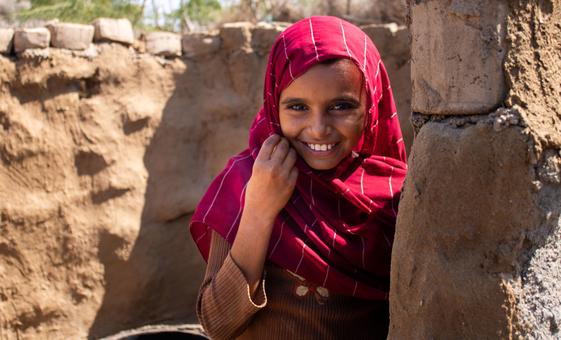Ongoing peace talks provide a glimpse of hope that a political resolution to the conflict is on the horizon.
However, on International Day of Peace, celebrated annually on 21 September, humanitarian needs remain staggering and the funding to respond insufficient, as recently highlighted by almost 100 aid agencies.
Six months on from the last UN pledging conference for Yemen, only a fraction of what is required to meet the needs of millions has been pledged.

A displaced family in Marib, Yemen, carries a winter aid package back to their shelter.
Durable solutions needed
Despite a significant decrease in fighting since last year’s UN-brokered truce, over 4.3 million people remain displaced across the country. Most do not feel safe enough to return home anytime soon and plan to remain in the areas they have settled in for the foreseeable future.
Many are dispersed across hundreds of displacement camps in underdeveloped areas, mainly along the frontlines. Others have sheltered in urban areas or among host communities where social services are more readily available, yet poverty is rife.
In the long term, concrete, durable solutions for displaced communities who have settled in new areas, likely for the long haul, is crucial, according to the UN International Organization for Migration’s (IOM).
It adds that significant investments must be made to allow them to continue this lifesaving work and to promote a more sustainable future and long-term recovery through revitalizing agriculture, education, water systems, and other infrastructure.
water systems, and other infrastructure.

A migrant rests at a clinic in northern Yemen after a long and exhausting journey.
Trafficking crisis
Migrants remain some of those most vulnerable to the effects of the crisis. The maritime route migrants take from the Horn of Africa to Yemen is the second busiest in the world.
According to the IOM displacement tracking matrix, an estimated 90,000 migrants – mostly Ethiopian – have arrived on Yemen’s shores in 2023 so far, in the hopes of reaching Saudi Arabia.
Tens of thousands have become stranded. They have traveled too far and gone too deep in debt to turn around, but know the journey ahead is too deadly or costly to continue, according to IOM, whose staff hears daily accounts from migrants of exploitation at the hands of traffickers and grave abuse on their journeys.

A young migrant looks out to see after arriving in Yemen from Djibouti.
Slavery, torture, extortion
The migrants are often promised good jobs and decent living conditions and do not anticipate the challenges they will face. Instead, thousands of migrants are sold into sexual slavery, tortured on video while their families are extorted, or forced to work for months without pay on farms, according to IOM.
The situation has become a trafficking crisis of extraordinary proportions, the UN agency warned. Many also struggle to access essential public services, like health care, shelter, sanitation facilities, and food while also experiencing stigma and discrimination.
Humanitarians mobilized along the eastern corridor migration route are striving to ensure assistance is available to people on the move and that those who wish to return home can do so safely and voluntarily. But, the demand for these services continues to outweigh the resources available to respond to all migrants in need.
More meaningful efforts from world leaders to restore the rights of and end violence toward people on the move in Yemen – regardless of background or migration status – must also be made, the UN agency said.

IOM is providing services to patients at a health centre on the west coast of Yemen.
Yemenis welcome newcomers
Confronted with these harsh realities, it is Yemeni community members who often go out of their way to help newcomers. Thousands of Yemenis work for humanitarian agencies in dangerous areas. Some have moved far from their homes to lend a hand to communities in need across the country.
Host communities, still reeling from years of war, have stepped up to support and welcome those in dire need.
Yemeni doctors provide relief to people suffering from ailments on their journeys, engineers build extensive water networks in arid lands, community leaders help mitigate conflict over dwindling resources, and teachers spread knowledge to children whose education has been compromised by war.
The realization of the Sustainable Development Goals (SDGs) depends on supporting these unsung heroes to make concrete contributions to development and peace in countries in crisis.

